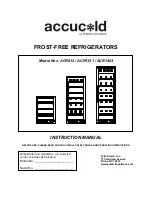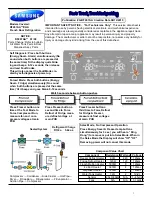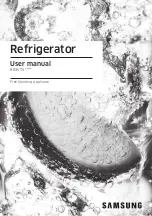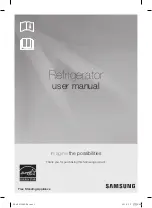
4.
HELPFUL HINTS AND TIPS
4.1
Hints for energy saving
• Do not open the door frequently or leave
it open longer than absolutely necessary.
• If the ambient temperature is high and
the Temperature Regulator is set to low
temperature and the appliance is fully
loaded, the compressor may run contin-
uously, causing frost or ice on the evap-
orator. If this happens, set the Tempera-
ture Regulator toward warmer settings to
allow automatic defrosting and so a sav-
ing in electricity consumption.
4.2
Hints for fresh food
refrigeration
To obtain the best performance:
• do not store warm food or evaporating
liquids in the refrigerator
• do cover or wrap the food, particularly if
it has a strong flavour
• position food so that air can circulate
freely around it
4.3
Hints for refrigeration
Useful hints:
Meat (all types) : wrap in polythene bags
and place on the glass shelf above the veg-
etable drawer.
For safety, store in this way only one or two
days at the most.
Cooked foods, cold dishes, etc..: these
should be covered and may be placed on
any shelf.
Fruit and vegetables: these should be thor-
oughly cleaned and placed in the special
drawer(s) provided.
Butter and cheese: these should be placed
in special airtight containers or wrapped in
aluminium foil or polythene bags to exclude
as much air as possible.
Milk bottles: these should have a cap and
should be stored in the bottle rack on the
door.
Bananas, potatoes, onions and garlic, if not
packed, must not be kept in the refrigera-
tor.
4.4
Hints for temperature inside
the fridge
• A suitable temperature inside the fridge
is approx. +4° C. When the temperature
regulator is set to +4° C this represents
the mean temperature in the fridge. It is
normal with higher temperature in the
top of the fridge. If the temperature regu-
lator is set to a cold temperature, the
ambient temperature is high or if the
fridge is fully loaded the compressor will
run for a longer time. If too cold, change
to a higher temperature setting.
Do not place food against or close
to the temperature sensor (A). This
can result in too cold temperatures.
A
• If you want to check the temperature of
food stored in the refrigerator, place a
glass of water centrally in the cabinet,
and put a proper thermometer with an
accuracy of +/– 1 °C into it. After 6 hours
the temperature can be monitored. The
measuring shall be performed under
steady-stated conditions (without chang-
ing the load).
5.
CARE AND CLEANING
CAUTION!
Unplug the appliance before carry-
ing out any maintenance operation.
This appliance contains hydrocar-
bons in its cooling unit; mainte-
nance and recharging must there-
fore only be carried out by author-
ized technicians.
ENGLISH
9






































